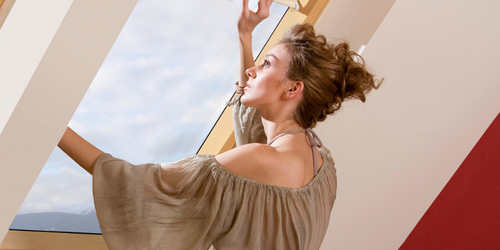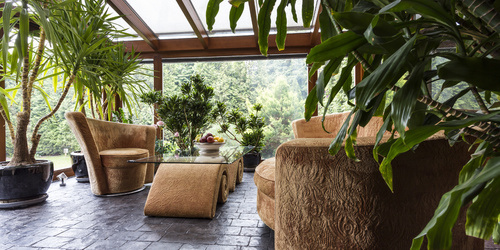Attic protection against heating

Utility attic rooms, among everyone in the house, are most exposed to excessive heating. They affect the windows and the entire roof space. 80% window panes...
More »External window shadings are devices installed on the exterior of buildings, designed to control the amount of sunlight entering the interior and to influence the building's thermal insulation. The most popular types of external window shadings include external blinds, awnings, shutters, and louvres.
External window shadings play a key role in the energy efficiency of buildings, especially during the winter period. By reducing heat loss and controlling the access of sunlight, these shadings can significantly impact the energy required for heating interiors.
Building energy efficiency refers to the way energy is used to maintain thermal comfort inside a building. This includes heating, cooling, lighting, and other aspects of energy consumption. In winter, the main goal is to minimize heat loss and maximize internal heat gains.
Windows are one of the main areas through which heat escapes from buildings. Heat loss through windows can occur in several ways, including conduction, convection, radiation, and air leaks. In winter, when the temperature difference inside and outside is significant, these losses can be severe.
External window shadings can significantly reduce heat loss through windows. By creating an additional thermal barrier, they reduce the flow of heat from the interior of the building to the outside. This effect is achieved thanks to the insulating properties of the materials used for the shadings, and by creating an air layer between the shading and the window pane, which acts as an insulator.
External blinds: Typically made of plastic or metal, these blinds are effective in preventing heat loss. Some models are equipped with insulating layers for better efficiency.
Awnings: Although more commonly used for sun protection in summer, awnings can also provide additional insulation in winter.
Louvres: Metal or wooden louvres can reduce heat loss, but their efficiency depends on the quality of installation and material.
Shutters: Traditional shutters, especially those with insulating materials, can significantly improve the thermal insulation of windows.
Reducing heat loss through windows not only lowers heating bills but also contributes to reducing carbon dioxide emissions. More efficient energy use means less demand for fossil fuels and a smaller carbon footprint.
Appropriate use of external window shadings can significantly contribute to improving the thermal insulation of a building, which is key to maintaining thermal comfort and energy efficiency during the winter period.

Sunlight plays a significant role in heating buildings in winter. Sun rays, penetrating through windows, can naturally warm interiors, thereby reducing the need for artificial heating.
External window shadings allow control over the amount of sunlight entering the interior. In winter, the ability to adjust allows for maximum use of natural solar heat during the day, while limiting heat loss at night.
External blinds: Allow for complete control of incoming light. They can be fully closed to retain heat at night or partially opened during the day.
Awnings: Effective in blocking direct sunlight, awnings can be used to control temperatures inside rooms, especially for south-facing windows.
Louvres: Allow for precise regulation of the amount of light and heat entering rooms.
Shutters: Offer full light blockage when closed, and their design can also contribute to additional thermal insulation.
Proper adjustment of shadings can increase heat gains during the day and reduce losses at night. This is particularly important in winter months when days are shorter and nights longer.
Using external window shadings to regulate sunlight can significantly contribute to increasing a building's energy efficiency in winter. They allow for the use of free solar heat during the day and help retain heat inside the building at night.
Choosing appropriate external window shadings depends on several factors, including climate, window orientation, the architectural style of the building, and individual user needs. It's important to select shadings that are not only energy-efficient but also match the building's aesthetics.
The installation of external window shadings can be complex and requires expert knowledge. It's important to ensure proper installation to maximize the benefits of thermal insulation and sunlight control:
Ensuring airtightness: It's essential that the shadings are well-fitted to the windows to avoid air leaks.
Choosing the right mechanism: It's important to select a mechanism that allows easy adjustment of the shadings, especially for large windows.
Regular maintenance of window shadings is key to their long-term efficiency:
Cleaning: Regular cleaning of shadings helps maintain their aesthetics and functionality.
Inspection and repair: Regular checks and repairs help prevent problems and extend the life of the shadings.
The cost of installing and maintaining external window shadings can be significant, but it should be considered in the context of energy and financial savings in the longer term.
Proper installation and maintenance of external window shadings are key to maximizing their energy benefits. It's important to pay attention to installation details and regularly care for the shadings to maintain their efficiency and aesthetic appearance.

In recent years, there has been significant progress in the technology of external window shadings. These innovations focus on increasing energy efficiency, improving functionality and aesthetics, and integration with smart home systems.
One of the most important innovations is smart control systems, which allow for automatic adjustment of shadings based on external conditions such as sunlight intensity, temperature, and weather conditions. This optimizes both heat gains and losses, translating to improved energy efficiency.
Modern window shadings can be equipped with materials with special thermal properties, such as UV-reflective coatings or heat-absorbing materials. These innovations help reduce the need for artificial heating in winter and cooling in summer.
Window shadings are an important element in the design of passive buildings, aimed at maximum energy efficiency. By integrating shadings with the overall concept of the building, even more efficient energy management is possible.
External window shadings are also becoming an important element in urban design, especially in the context of combating climate change. By reducing energy demand, they contribute to reducing the carbon footprint of cities.
Future trends and innovations in external window shadings focus on increasing energy efficiency and integration with modern building systems. The development of these technologies will be key to future energy management strategies in buildings and for long-term sustainable urban planning.

Utility attic rooms, among everyone in the house, are most exposed to excessive heating. They affect the windows and the entire roof space. 80% window panes...
More »
When we think about what to choose as a window cover, we more often decide on blinds. Numerous advantages make their popularity steadily growing. The wide...
More »
Beautiful winter weather outside; snow and sun. And it was winter that "thought" us of today's blog topic. A somewhat contradictory topic, because winter is...
More »